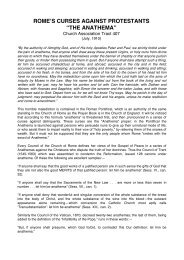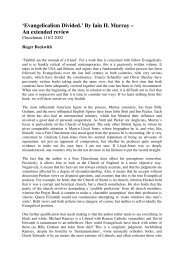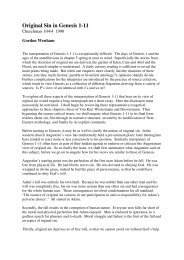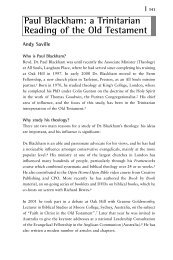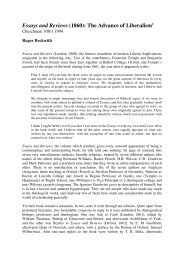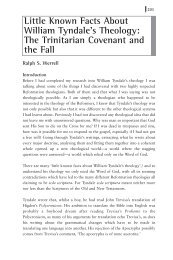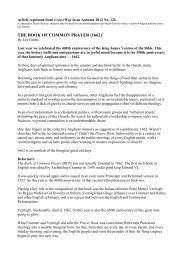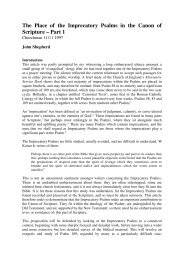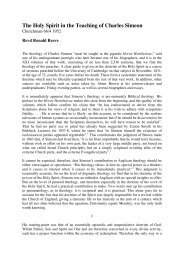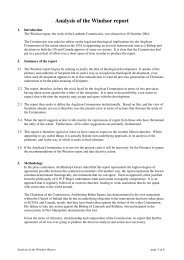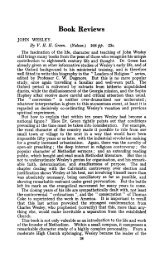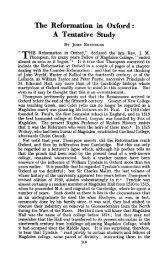SCARF OR STOLE - Church Society
SCARF OR STOLE - Church Society
SCARF OR STOLE - Church Society
You also want an ePaper? Increase the reach of your titles
YUMPU automatically turns print PDFs into web optimized ePapers that Google loves.
<strong>SCARF</strong> <strong>OR</strong> <strong>STOLE</strong><br />
WHAT DOES IT MATTER?<br />
Does it really matter what the clergy wear? - especially in these<br />
days of ecumenical experiment and debate? Since 1965 Canon<br />
Law has permitted varying kinds of vesture in the <strong>Church</strong> of<br />
England, so surely we do not need to make a fuss over these issues<br />
any more? At first glance that seems a reasonable argument, until<br />
you recall how much the things we do in worship affect the way we<br />
think about it. If such things were not important, why all the<br />
reordering of our churches, moving the communion table from the<br />
east end to the nave, and removing pews to form ‘worship areas’?<br />
Similarly, what the clergyman wears affects people’s understanding<br />
of the services and are ‘teaching aids’ of a sort. To wear one form<br />
of ministerial dress when the Word of God is read and preached,<br />
and a more elaborate form of dress for sacramental services, will<br />
say more to the onlooker than many clergy will wish to imply.<br />
UNITY OF MINISTRY<br />
The <strong>Church</strong> of England has, ever since the Reformation, rightly<br />
stressed the unity of the ministry of Word and Sacrament. In the<br />
Ordinal annexed to the Book of Common Prayer the bishop’s words
to the candidate he ordains to the priesthood (or presbyterate) are<br />
‘Receive the Holy Ghost for the office and work of a Priest in the<br />
<strong>Church</strong> of God. And be thou a faithful dispenser of the Word of<br />
God, and of his holy Sacraments. ‘ He then delivers the Bible into<br />
the ordinand’s hands saying, ‘Take thou authority to preach the<br />
Word of God, and to minister the holy Sacraments. ‘ This twofold<br />
emphasis remains the thrust of the modern language ordinal of the<br />
Alternative Service Book.<br />
The Reformers were well aware of the need to back up their words<br />
by the use of visual aids. So they emphasized the primacy of the<br />
ministry of the Word of God by requiring the bishops to give their<br />
ordinands a Bible only, and not the chalice and paten as well, which<br />
had been required in Cranmer’s first ordinal of 1550. The second<br />
(1552) English Prayer book also reinforced this emphasis on the<br />
unity of the ministry by requiring that ‘the minister at the time of<br />
the Communion and all other times in his ministration shall use<br />
neither albe, vestment, nor cope; but being archbishop or bishop,<br />
he shall have and wear a rochet; and being a preest or deacon, he<br />
shall have and wear a surplice onely’.<br />
With the Elizabethan Settlement of 1559, which reintroduced the<br />
Second Prayer Book with only small amendments, the Elizabethan<br />
Advertisements of 1566 (sometimes dated to 1565) appear to<br />
reinstate this practice which would stress the unity of the ministry.<br />
This is certainly how it was understood generally in England for<br />
virtually 300 years.<br />
INTRODUCTION OF <strong>STOLE</strong><br />
It was only in the last century that the growth of the Tractarian<br />
Movement led to the reintroduction of the stole in the <strong>Church</strong> of<br />
England. In the life of Archbishop Tait it is recorded how, when he<br />
was Bishop of London, at the consecration of St Michael’s <strong>Church</strong> in
Shoreditch, he requested a clergyman who was wearing a stole to<br />
take it off and added, ‘I must ask the clergy of my diocese who are<br />
here today to wear the simple dress of the clergymen of the<br />
<strong>Church</strong> of England’.<br />
In spite of such attempts to retain the Reformers’ position, Anglocatholics<br />
continued to press for the wearing of the stole along with<br />
other ‘Mass’ vestments in an attempt (especially after the Papal<br />
Bull of 1896 refused to recognize Anglican orders) to show that at<br />
the Communion they had the same ‘intention’ as Roman Priests.<br />
Their persistency gradually led to the increased wearing of the<br />
stole by other clergy. Things came to a head in the 1950s when<br />
two leading Anglo-catholic bishops, Wand of London and Kirk of<br />
Oxford, refused to ordain candidates who would not wear a stole at<br />
ordination. Previously bishops had allowed a variety of vesture;<br />
many ordinands were ordained in the traditional scarf and hood,<br />
while a number of bishops at that time allowed those who so<br />
wished to wear the stole. Wand ordained his candidates at St<br />
Paul’s Cathedral; those who refused the stole were given a private<br />
ordination by one of his suffragans in Fulham Palace Chapel. Kirk<br />
insisted that stole-less ordinands should be ordained by Letters<br />
Dimissory by another bishop, and Chavasse of Rochester usually<br />
obliged.<br />
PROTEST<br />
It was at this time that some of the principals of the evangelical<br />
colleges protested on behalf of ordinands who were being<br />
subjected to this unwarranted pressure, and in response<br />
Archbishop Geoffrey Fisher wrote to all bishops and principals to<br />
instruct them that ‘no candidate should be refused ordination on<br />
the grounds on his being unwilling to wear a stole’.
Fisher was conscious of the fact that the ritual prosecutions of the<br />
late nineteenth century had shown that such matters as the<br />
vesture of ministers were at least debatable, and so he pushed<br />
ahead with the revision of Canon Law. The intention of this was to<br />
authorise the variety of uses in the <strong>Church</strong> of England, without<br />
suggesting that any was preferable or more authentically Anglican,<br />
especially as the fifth paragraph of Canon 88, ‘Of the Vesture of<br />
Ministers’, states specifically that ‘The <strong>Church</strong> of England does not<br />
attach any particular doctrinal significance to the diversities of<br />
vesture permitted by this Canon, and the vesture worn by the<br />
minister in accordance with the provisions of this Canon is not to<br />
be understood as implying any doctrines other than those now<br />
contained in the formularies of the <strong>Church</strong> of England’.<br />
At the time that the revised Canons were being debated in the old<br />
<strong>Church</strong> Assembly, evangelicals, who were uneasy about the<br />
changes which would undermine their understanding of the legal<br />
position since the Elizabethan Settlement and the Canons of 1604,<br />
were reassured that the purpose of this revision was to recognize<br />
the variety of vesture in the <strong>Church</strong> of England not not to impose<br />
uniformity,<br />
NEW TRADITION?<br />
Publication of the Alternate Service Book in 1980 included the<br />
revised ordinal, where it is stated that ‘Where it is agreed that<br />
those to be ordained are to be clothed in their customary vesture,<br />
it is appropriate that this should take place at any time after the<br />
Declaration’. When this was first produced the agreement referred<br />
to was assumed by some to be between the candidate and his<br />
ordaining bishop; current practice suggests that it is more likely to<br />
be between the bishop and the dean or provost of his cathedral.<br />
As those appointed to such offices in the church today appear to<br />
be selected solely from among the clergy who are prepared to use
stoles, little consideration is given to the candidate who is not<br />
happy in conscience to be made part of this ceremony. Jasper and<br />
Bradshaw in their latest Companion to the ASB say (page 446) that<br />
‘A relic of the traditional vesting has returned in recent years,<br />
however. It is now customary for deacons to be vested after<br />
ordination with a stole over the left shoulder and tied under the<br />
right arm, and priests after ordination to be vested with a stole<br />
over both shoulders.’<br />
There is consequently a tradition growing in our church that at<br />
ordination (in particular, but also at other ‘diocesan’ services in our<br />
cathedrals) clergy should conform to the norm and wear stoles, and<br />
ordinands agree to being vested in them.<br />
Some bishops have even argued that if they allow evangelicals to<br />
wear scarf and hood, then Anglo-catholics should be permitted to<br />
wear the chasuble. This is strange reasoning, as the chasuble has<br />
never (until the revised Canons) been an accepted part of Anglican<br />
vesture, while the scarf and hood have been for three centuries and<br />
more the Anglican norm.<br />
We are making these facts known at this time in a plea that<br />
bishops should be prepared to give more consideration to the<br />
sensitivities of their clergy, and especially of ordinands at a very<br />
important time in their lives, and allow flexibility in usage. The<br />
practice of the <strong>Church</strong> of England for 300 years prior to the advent<br />
of the Oxford Movement must not be laid aside as being of no<br />
consequence. In the Reformed <strong>Church</strong> of England clergy should be<br />
allowed to wear Reformed dress.
For further articles and other issues see<br />
www.churchsociety.org<br />
<strong>Church</strong> <strong>Society</strong> exists to promote a biblical faith which shapes both the<br />
<strong>Church</strong> of England and the society in which we live for the sake of Christ.<br />
Such a faith is carefully expressed in the 39 Articles of Religion and in the<br />
Protestant liturgy entrusted to us after the reformation.<br />
<strong>Church</strong> <strong>Society</strong> works through publishing, supporting churches,<br />
campaigning and the administration of charitable trusts and properties.<br />
If you long to see the <strong>Church</strong> of England upholding a clear biblical faith<br />
and being a faithful witness in the nation then we invite you to join us.<br />
Please contact:<br />
<strong>Church</strong> <strong>Society</strong>, Dean Wace House,<br />
16 Rosslyn Road,<br />
Watford WD18 0NY<br />
Tel : 01923-235111 Fax : 01923-800363<br />
admin@ churchsociey.org



